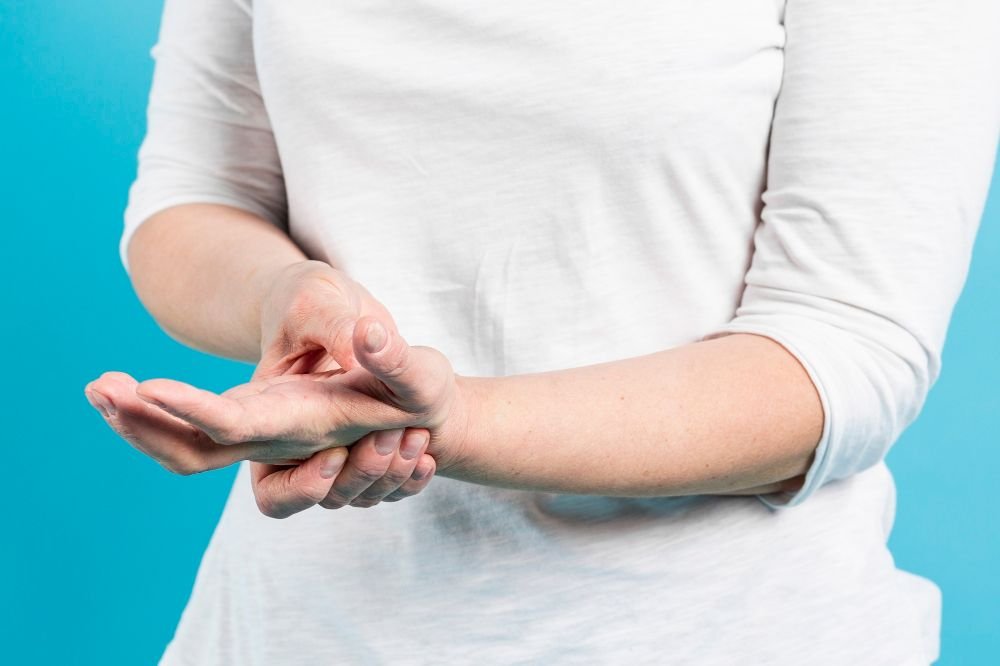Joint pain in thumb can be a common and debilitating condition that affects individuals of all ages. It can interfere with daily activities and impact overall hand function. In this article, we will explore the causes, symptoms, and treatment options for joint pain in the thumb, providing valuable insights for those seeking relief and understanding.

Understanding Thumb Joint Anatomy
The thumb joint, also known as the carpometacarpal (CMC) joint, is located at the base of the thumb where it meets the wrist. It is a highly mobile joint that allows various movements such as flexion, extension, abduction, adduction, and opposition. The CMC joint is supported by ligaments, tendons, and cartilage, which work together to provide stability and facilitate smooth movement.
Common Causes of Joint Pain in the Thumb
Osteoarthritis:
Osteoarthritis is the most common cause of joint pain in the thumb. It occurs when the protective cartilage that covers the ends of bones wears down over time, leading to pain, inflammation, and stiffness.
Rheumatoid Arthritis:
Rheumatoid arthritis is an autoimmune condition that affects multiple joints, including the thumb. It causes chronic inflammation, leading to joint damage and pain.
Traumatic Injuries:
Injuries such as fractures, dislocations, or sprains in the thumb can result in joint pain. These injuries may damage the ligaments, tendons, or bones in the thumb joint.
Tendinitis:
Tendinitis occurs when the tendons in the thumb become inflamed or irritated. This can be caused by repetitive thumb movements or overuse of the joint.
De Quervain’s Tenosynovitis:
De Quervain’s tenosynovitis is a condition that affects the tendons on the thumb side of the wrist. It causes pain and swelling in the thumb and wrist area.
Recognizing the Symptoms
Pain and Swelling:
Individuals with thumb joint pain may experience localized pain and swelling around the base of the thumb. The pain may worsen with thumb movement or gripping.
Stiffness and Limited Range of Motion:
Thumb joint stiffness and a reduced range of motion can make it difficult to perform daily tasks that require thumb movement, such as grasping objects or writing.
Weakness and Instability:
Joint pain in the thumb can lead to weakness and a sense of instability. Individuals may find it challenging to hold or grip objects firmly.
Diagnosis and Medical Evaluation

To diagnose the underlying cause of thumb joint pain, a medical evaluation is necessary. This may involve:
Physical Examination:
A healthcare professional will assess the affected thumb, looking for signs of inflammation, tenderness, or instability. They may also evaluate the range of motion and strength of the thumb joint.
Imaging Tests:
X-rays, MRI scans, or ultrasound may be recommended to visualize the bones, joints, and soft tissues in the thumb. These tests can help identify any structural abnormalities or signs of arthritis.
Laboratory Tests:
Blood tests may be conducted to check for markers of inflammation or specific antibodies associated with autoimmune conditions like rheumatoid arthritis.
Non-Surgical Treatment Options
In many cases, thumb joint pain can be managed through non-surgical treatment options. These may include:
Rest and Immobilization:
Resting the thumb joint and avoiding activities that exacerbate the pain can promote healing. Immobilization through splinting or bracing may be recommended to provide stability and alleviate stress on the joint.
Medications:
Over-the-counter pain relievers, such as nonsteroidal anti-inflammatory drugs (NSAIDs), can help reduce pain and inflammation. In some cases, corticosteroid injections may be administered for more severe symptoms.
Splinting and Bracing:
Wearing a thumb splint or brace can provide support and protect the joint from further damage. These devices can be particularly helpful during activities that strain the thumb.
Physical Therapy:
A physical therapist can design a customized exercise program to strengthen the muscles around the thumb joint and improve flexibility. They may also employ techniques like ultrasound or electrical stimulation for pain relief.
Hand Exercises:
Specific exercises that target the thumb joint can help improve its mobility and strength. These exercises may involve thumb opposition movements, finger stretches, and gripping exercises.
Hot and Cold Therapy:
Applying heat or cold to the thumb joint can help reduce pain and inflammation. Heat therapy, such as warm compresses, can promote blood circulation, while cold therapy, such as ice packs, can numb the area and alleviate swelling.
Surgical Treatment Options
In cases where non-surgical treatments do not provide sufficient relief, surgical intervention may be considered. The following are common surgical treatment options for thumb joint pain:
Arthroscopy:
Arthroscopy is a minimally invasive procedure that involves using small incisions and a camera to visualize and repair the thumb joint. It can be used to remove damaged tissue or smooth out irregularities.
Joint Fusion:
Joint fusion, also known as arthrodesis, involves permanently fusing the bones of the thumb joint together. This eliminates movement but can significantly reduce pain.
Joint Replacement:
In severe cases of thumb joint pain, joint replacement surgery may be recommended. This procedure involves removing the damaged joint and replacing it with an artificial joint made of metal, plastic, or silicone.
Lifestyle Modifications and Self-Care

In addition to medical interventions, certain lifestyle modifications and self-care practices can help manage thumb joint pain:
Healthy Diet and Weight Management:
Maintaining a balanced diet and a healthy weight can reduce stress on the joints, including the thumb joint. Incorporating foods rich in omega-3 fatty acids and antioxidants may also have anti-inflammatory benefits.
Ergonomic Modifications:
Making ergonomic adjustments to workstations and tools can alleviate strain on the thumb joint. This may involve using cushioned grips, ergonomic keyboards, or adjustable chairs to maintain proper hand and wrist positions.
Thumb Exercises and Stretching:
Engaging in regular thumb exercises and stretching can promote flexibility and strengthen the muscles around the joint. These exercises should be done under the guidance of a healthcare professional or a qualified therapist.
Assistive Devices:
Utilizing assistive devices, such as jar openers, button hooks, or specialized utensils, can help reduce the strain on the thumb joint during daily activities.
Prevention Tips
While some causes of thumb joint pain may be unavoidable, the following tips can help minimize the risk or progression of joint pain:
Maintain a Healthy Lifestyle:
Regular exercise, a balanced diet, and adequate rest can contribute to overall joint health. Avoiding smoking and excessive alcohol consumption is also beneficial.
Practice Joint Protection:
When engaging in activities that put stress on the thumb joint, such as gardening or playing sports, using proper techniques and supportive gear can help protect the joint from injury.
Avoid Overusing or Straining the Thumb:
Take breaks and alternate activities to avoid repetitive thumb movements. If possible, distribute tasks among multiple fingers to reduce strain on the thumb.
When to Seek Medical Attention
If thumb joint pain persists, worsens, or significantly affects daily activities despite conservative treatments, it is advisable to seek medical attention. A healthcare professional can provide a comprehensive evaluation, diagnose the underlying cause, and recommend appropriate treatment options.
Conclusion
Joint pain in the thumb can be a debilitating condition that impacts daily life. Understanding the causes, recognizing the symptoms, and exploring various treatment options can help individuals find relief and regain thumb functionality. By adopting lifestyle modifications, engaging in self-care practices, and seeking medical guidance when needed, individuals can effectively manage thumb joint pain and improve their overall quality of life.
FAQs (Frequently Asked Questions)
1.Can joint pain in the thumb be a sign of arthritis?
Yes, joint pain in the thumb can be a symptom of arthritis, particularly osteoarthritis or rheumatoid arthritis.
2.Are there any natural remedies for relieving thumb joint pain?
While natural remedies like applying warm compresses or using herbal supplements may provide temporary relief, it is essential to consult with a healthcare professional for a proper diagnosis and treatment plan.
3.Can joint pain in the thumb be caused by repetitive motion?
Yes, repetitive thumb movements, such as those involved in certain occupations or hobbies, can lead to joint pain and conditions like tendinitis.
4.Is thumb joint pain more common in women than men?
Thumb joint pain can affect both men and women, although certain conditions like osteoarthritis tend to be more prevalent in women.
5.Can joint pain in the thumb be prevented through exercise?
Regular exercise, including thumb exercises and stretching, can help maintain thumb joint flexibility and strengthen the surrounding muscles. However, it may not prevent all causes of thumb joint pain, especially those related to arthritis or traumatic injuries.





